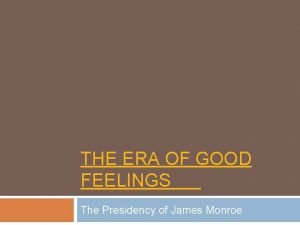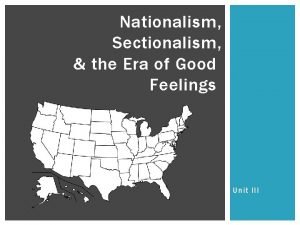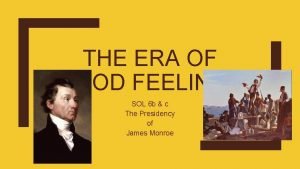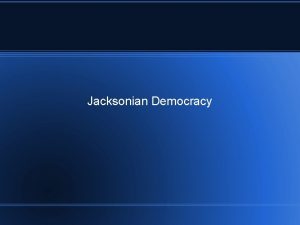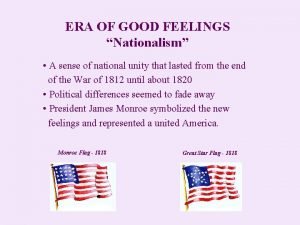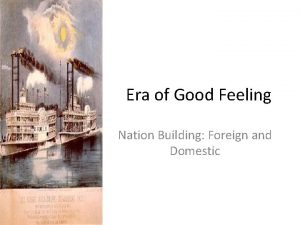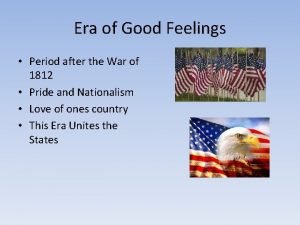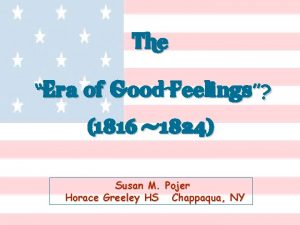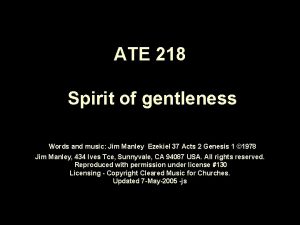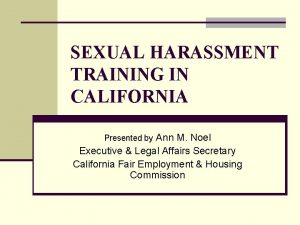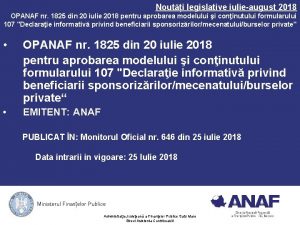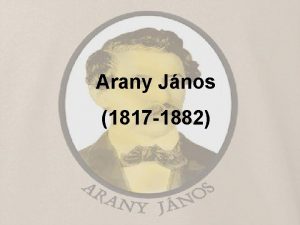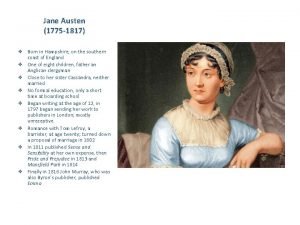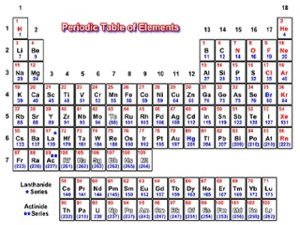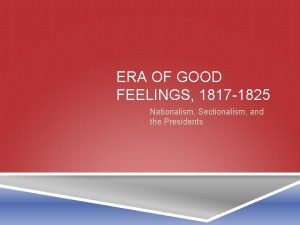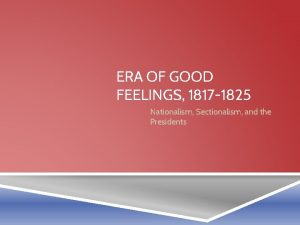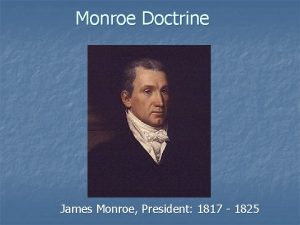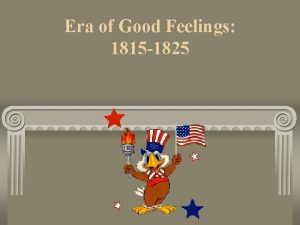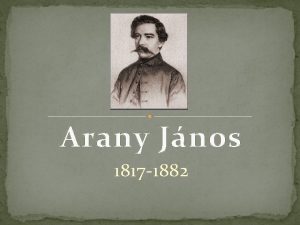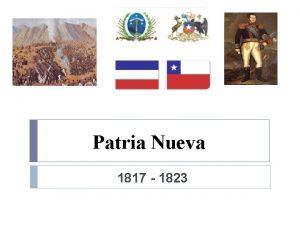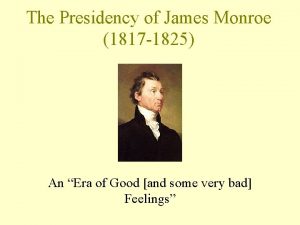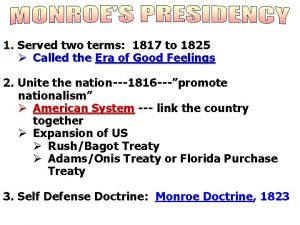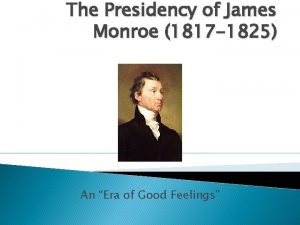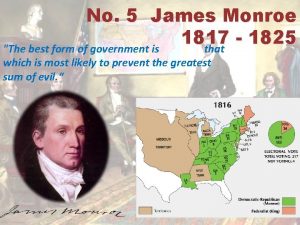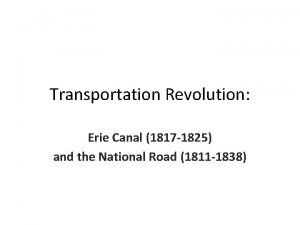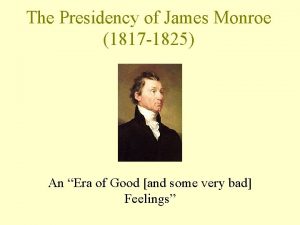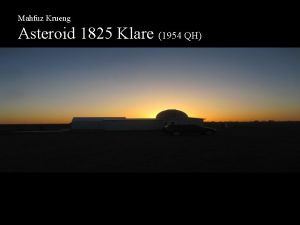Era of Good Feelings 1817 1825 Spirit of

























- Slides: 25

Era of Good Feelings 1817 -1825

§ Spirit of Nationalism in US § patriotism or national oneness § Country is united, confident, and growing § 1791 -1819, 9 states joined the original 13. § One political party---Republican party § Respect from Europe § Monroe first president to visit all states since Washington. § Boston newspaper declared an “Era of Good Feelings” had begun. § But, time period was not free of problems.

• Cultural Nationalism • Patriotic themes infused every aspect of American society from books and paintings of Revolutionary heroes to Noah Webster’s blue-backed speller that promoted patriotism • Economic Nationalism • Running parallel with cultural nationalism was a political movement to support the growth of the nation’s economy-------AMERICAN SYSTEM • Political Nationalism • Movement to bring about the support for national government is over the states. Supreme court decisions support the concept of national government over the states.

Henry Clay’s American System § Provide economic growth § Americans buying American goods § American self-sufficiency. § Protective Tariff to promote infant industry § Tariff of 1816 § 2 nd BUS to promote a stronger economy § Rechartered in 1816 § Congress’s attempt to unite the US § National transportation system of roads, canals, steamships and rivers.

§ National Transportation system § Cumberland Road and Erie Canal first internal improvements to unite the US § the first steamboat on western waters was in 1811. § 1800 to 1850 roads, canals and rivers first forms of transportation § 1850 to 1860 the railroad is added § The Land Act of 1820 § gave the West its wish by authorizing a buyer to purchase 80 acres of land at a minimum of $1. 25 an acre in cash; § the West demanded transportation.

Map roads/canals • Help unite the country as well as improve the economy and the infant industry…. • Because of the British blockade during the War of 1812, it was essential for internal transportation improvements.

§ Population shift from the east to the West § Acquisition of Native Americans’ lands § Land easy to obtain § Economic pressures § Improved transportation § Immigration

New Questions and Issues § Greatest importance to western states were: § “Cheap money” (easy credit) from state banks rather than from the Bank of the United States § Land made available at low prices by the government § Improved transportation § Westerners could not agree whether to permit slavery or exclude it

The Panic of 1819 • Largely the fault of the Second Bank of the United States’ tightening of credit in an effort to control inflation • Many state banks closed • The value of money fell • There were large increases in unemployment, bankruptcies, and imprisonment for debt • Depression was most severe in the West • The economic crisis changed many Western voters’ political outlook


City growth Westward expansion Growth of cities and states by 1850



• Rush-Bagot Agreement (1817) • Limits naval presence on Great Lakes for U. S. and Great Britain • Anglo-American Convention (1818) • Shared Oregon Territory for 10 years • the setting of the northern limits of the Louisiana Territory at the 49 th parallel


• Florida Becomes Part of US • After War of 1812, Spain had difficulty governing Florida • Seminole Indians, runaway slaves, and white outlaws conducted raids into U. S. territory and retreated to safety across the Florida border • President Monroe commissioned General Andrew Jackson to stop the raiders –Jackson led a force into Florida, destroyed Seminole villages, and hanged 2 Seminole chiefs –Jackson captured Pensacola and drove out the Spanish governor


• Adams-Onis Treaty (1819) • Spain turned over • western Florida along with all to the east • Claims in the Oregon Territory to the U. S. • US agreed • to pay $5 million to Spain • to give up any territorial claims to Texas

49 th Parallel Rush-Bagot Treaty and Anglo-American Convention 1817 -1818 Adams-Onisof Treaty of with Britain 1819 Great with Spain Texas

monroe doctrine • Monroe was responding to the threat that Europe might try to aid Spain in winning back her former Latin American colonies. • Great Britain, with its powerful navy, also opposed re-conquest of Latin America and suggested that the US join in proclaiming "hands off. " • Not only must Latin America be left alone, but Russia must Monroe and Secretary of State John Quincy Adams not encroach southward on the Pacific coast. wanted to protect new “republics” in the Western Hemisphere.

• Referred to as America’s Self Defense Doctrine. • continuation of President Washington’s neutrality and isolationist policies. • Past problems with Europe led the US to declare the Americas off-limits to Europe US recognized existing European Colonies US will stay out of European affairs Monroe Doctrine US protector of new democracies in the Western Hemisphere No European Colonization in the Americas

U. S. was becoming divided into 3 separate sections with each trying to promote their self-interest. NORTHEAST • Business and Manufacturing Daniel Webster ________ • Wanted Tariffs Role of Government • Backed internal improvements End to cheap public land • Increasingly nationalistic • Against Slavery and believed the U. S. Govt. must abolish it. Economy Leader ______ SOUTH WEST • Cotton-growing John C. Calhoun • Frontier agriculture Henry Clay ________ • Supported internal improvements and American System. • Wanted cheap land • Loyal to the U. S. Govt. • Against slavery but some supported letting the people decide the slavery issue • Opposed tariffs and government spending on American System • Increasingly supportive of states’ rights • Pro-slavery and opposed any steps of the U. S. Govt. to try and abolish it.

In 1819, Missouri, first part of the Louisiana Purchase to apply for statehood • Threatened balance of power in Congress • 11 free states • 11 slave states • The Tallmadge amendment • prohibited the further introduction of slaves into Missouri • All slaves born in Missouri after the territory became a state would be freed at the age of 25. • Passed by the House, not in the Senate. • The North controlled the House, and the South had enough power to block it in the Senate.

After months of heated debate in Congress, Henry Clay won majority support for 3 bills that represented a compromise • Missouri was to be admitted as a slaveholding state • Maine was to be admitted as a free state • In the rest of the Louisiana Territory north of latitude 36 30', slavery was prohibited

 Feelings feelings feelings
Feelings feelings feelings Era of good feelings political cartoon
Era of good feelings political cartoon Era of good feelings nationalism
Era of good feelings nationalism Era of good feelings facts
Era of good feelings facts Era of good feelings timeline
Era of good feelings timeline What does era of good feelings mean
What does era of good feelings mean Era of good feelings
Era of good feelings Whats the era of good feelings
Whats the era of good feelings Era of good feelings simple definition
Era of good feelings simple definition Era of good feelings facts
Era of good feelings facts Come holy spirit dove divine
Come holy spirit dove divine Spirit spirit of gentleness
Spirit spirit of gentleness Ab 1825 supervisor definition
Ab 1825 supervisor definition Music of the classical period (1750 to 1820)
Music of the classical period (1750 to 1820) 17 novembre 1825 a neuchâtel
17 novembre 1825 a neuchâtel 1750-1825
1750-1825 1750-1825
1750-1825 Opanaf 1825 din 2018
Opanaf 1825 din 2018 Thaumatrope
Thaumatrope 1817-1882
1817-1882 1817 periodic table
1817 periodic table 1817 hampshire drive
1817 hampshire drive Acontecimientos patria nueva
Acontecimientos patria nueva 1817 periodic table
1817 periodic table Epidemiology concept
Epidemiology concept Virtud teologal esperanza
Virtud teologal esperanza

